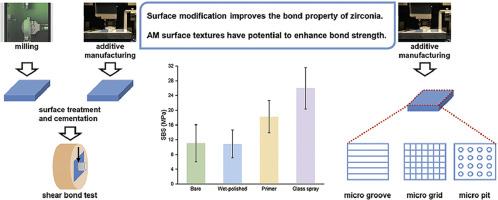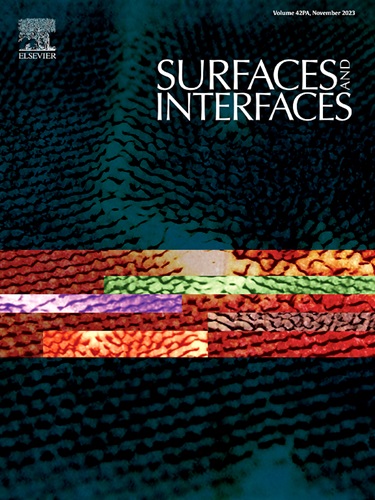Shear bond strength of resin to additively manufactured zirconia with different surface treatments
IF 5.7
2区 材料科学
Q2 CHEMISTRY, PHYSICAL
引用次数: 0
Abstract
Background
Additive manufacturing is increasingly being utilized for dental restorations, but debonding remains a common issue with zirconia restorations. In particular, there is limited research on the bonding properties between additively manufactured (AM) zirconia and resin cement.
Aim
This study aimed to evaluate and compare the shear bond strength (SBS) of resin to milled and AM zirconia, and to investigate the effect of different surface treatments.
Material and methods
Milled and AM zirconia specimens were subjected to various surface treatment methods: wet-polished group (MW&AW), where milled or AM zirconia was wet-polished with no additional treatment; primer group (MP&AP), where wet-polished zirconia was treated with primer; glass spray group (MG&AG), where wet-polished zirconia was coated with glass; and the bare group (AB), consisting of unpolished AM zirconia with preserved surface texture. Shear bond strength, surface roughness, morphology, and elemental distribution were analyzed using a universal mechanical testing machine, laser scanning microscope, scanning electron microscope, and micro X-ray fluorescence spectrometer, respectively.
Results
The untreated groups showed the lowest SBS values (MW=6.82±2.35 MPa, AW=10.86±3.79 MPa), while the highest SBS values were observed in the glass coating groups (MG=23.06±3.86 MPa, AG=25.96±5.60 MPa). There was no significant difference in SBS between milled and AM zirconia with the same surface treatment. Additionally, the bare AM zirconia group exhibited slightly higher SBS than that of the wet-polished AM zirconia group.
Conclusions
Surface treatments significantly enhance the shear bond strength between AM zirconia and resin, achieving bond strength levels comparable to those of milled zirconia. In addition, the unique surface textures of AM zirconia, enabled by its design and manufacturing flexibility, hold potential to further enhance bond properties.

不同表面处理的树脂与添加型氧化锆的剪切粘接强度
背景快速成型技术越来越多地用于牙科修复,但脱粘仍然是氧化锆修复体的常见问题。本研究旨在评估和比较树脂与研磨氧化锆和 AM 氧化锆的剪切粘结强度(SBS),并探讨不同表面处理方法的影响。材料和方法对研磨和调聚氧化锆试样采用不同的表面处理方法:湿抛光组(MW&AW),对研磨或调聚氧化锆进行湿抛光,不做额外处理;底漆组(MP&AP),对湿抛光氧化锆进行底漆处理;玻璃喷涂组(MG&AG),对湿抛光氧化锆进行玻璃喷涂;裸组(AB),包括未抛光的调聚氧化锆,保留表面纹理。结果 未处理组的 SBS 值最低(MW=6.82±2.35 MPa,AW=10.86±3.79 MPa),而玻璃涂层组的 SBS 值最高(MG=23.06±3.86 MPa,AG=25.96±5.60 MPa)。表面处理相同的研磨氧化锆和 AM 氧化锆的 SBS 没有明显差异。结论表面处理可显著提高 AM 氧化锆和树脂之间的剪切粘结强度,达到与研磨氧化锆相当的粘结强度水平。此外,AM 氧化锆独特的表面纹理因其设计和制造的灵活性而具有进一步提高粘接性能的潜力。
本文章由计算机程序翻译,如有差异,请以英文原文为准。
求助全文
约1分钟内获得全文
求助全文
来源期刊

Surfaces and Interfaces
Chemistry-General Chemistry
CiteScore
8.50
自引率
6.50%
发文量
753
审稿时长
35 days
期刊介绍:
The aim of the journal is to provide a respectful outlet for ''sound science'' papers in all research areas on surfaces and interfaces. We define sound science papers as papers that describe new and well-executed research, but that do not necessarily provide brand new insights or are merely a description of research results.
Surfaces and Interfaces publishes research papers in all fields of surface science which may not always find the right home on first submission to our Elsevier sister journals (Applied Surface, Surface and Coatings Technology, Thin Solid Films)
 求助内容:
求助内容: 应助结果提醒方式:
应助结果提醒方式:


